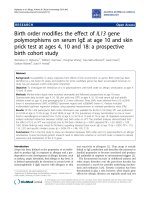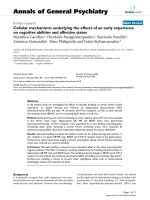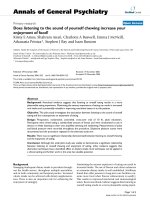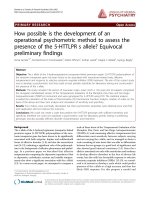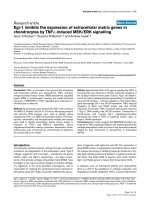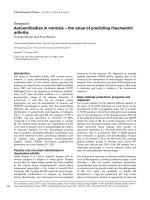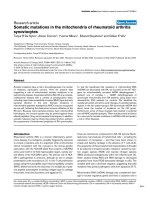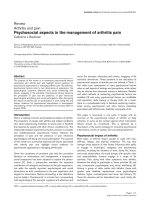Báo cáo y học: "Cardiac arrest - has the time of MRI come" ppt
Bạn đang xem bản rút gọn của tài liệu. Xem và tải ngay bản đầy đủ của tài liệu tại đây (115.24 KB, 2 trang )
In the past year, three studies have been published
evaluating the use of magnetic resonance imaging (MRI)
to determine the prognosis of patients suff ering out-of-
hospital cardiac arrest, a leading cause of death in
developed countries [1-3]. e initial survival of these
patients has improved recently thanks to the increased
availability of automated defi brillators and induced
hypothermia [4,5], leading to an increasing number of
patients hospitalized with post-anoxic coma. However,
survival rates without major neurological sequelae
remain low, and intensive care must be withdrawn in a
signifi cant number of patients who will otherwise evolve
to a vegetative or minimally conscious state. is decision
is currently based on clinical data. Lack of motor
response at 24 and 72 hours, absent corneal refl ex and
pupillary response at 24 hours have been shown to be
indicative of poor clinical outcome [6]. is approach,
however, has many limitations. While it can reliably pre-
dict a poor clinical outcome, prediction of good clinical
evolution is still diffi cult. Among patients with a good
clinical outcome, it is impossible to separate those who
will have a complete recovery (restitutio ad integrum)
from those whose quality of life will be hampered by
signifi cant neurological sequelae. Clinical examination
can provide variable results and is not com patible with
the deep sedation required by some thera peutic
protocols, especially hypothermia.
MRI is now widely available, and, with some precau-
tions, can be performed in patients under mechanical
ventilation. Despite the fact that MRI with diff usion-
weighted imaging (DWI) has been shown to effi ciently
detect anoxo-ischemic brain injury (especially in stroke),
its application for the evaluation of cardiac arrest patients
had not been developed until very recently. ree recent
papers attempt to address this issue.
In Critical Care, Choi and colleagues [1] have shown in
a series of 39 survivors of cardiac arrest that the presence
of lesions in both the cortex and basal ganglia on DWI
was strongly associated with a poor outcome. Moreover,
they could determine cut-off values of the apparent
diff usion coeffi cient (ADC; quantitative data that can be
extracted from the DWI sequence) that could predict this
outcome with 100% specifi city. Clinical decisions can
thus be made based on both reliable quantitative infor-
mation and images that are useful for explaining the
situation to the patient’s family. Wijman and colleagues
[2] have shown that brain volume with ADC values below
certain thresholds correlated with clinical outcome with
a better sensitivity than clinical examination. A study by
Wu and colleagues [3] basically combined these two
approaches and found similar results.
While promising, these three studies share some
limita tions. ey all included a limited number of patients.
Due to the rapid time-dependant variations of ADC, MRI
can only be performed early (2 to 5 days) after the cardiac
arrest, during a period when performing this examination
is potentially associated with a signifi cant risk, since
patients might still require catecholamine. Cut-off values
can predict a poor outcome with perfect specifi city but
less than perfect sensitivity, meaning that, as with clinical
examination, while the presence of lesions with a reduced
ADC beyond a defi ned threshold is strongly suggestive of
a poor outcome, a signifi cant number of subjects with a
‘good’ MRI will also still have a poor outcome. ey also
share the risk that, if the clinicians were not fully blinded
to the result of the MRI, some clinical decisions could
have been based on the results of the scan, leading to so-
called ‘self-fulfi lling prophecies’. Finally, all these studies
were monocentric. While ADC was initially supposed to
be a physical characteristic of the tissue, signifi cant varia-
tions in its measurement have been reported, depending
Abstract
Three recent articles have shown the potential use
of magnetic resonance imaging for the evaluation
of comatose survivors of cardiac arrest. While this
technique appears promising, signi cant additional
work is required before it can be routinely used in a
clinical setting.
© 2010 BioMed Central Ltd
Cardiac arrest - has the time of MRI come?
Damien Galanaud* and Louis Puybasset
See related research by Choi et al., />COMMENTARY
*Correspondence:
Department of Neuroradiology and Neurosurgical Intensive Care Unit Pitié
Salpêtrière Hospital and Université Pierre et Marie curie (Paris VI), Paris 75013,
France
Galanaud and Puybasset Critical Care 2010, 14:135
/>© 2010 BioMed Central Ltd
on the MRI device [7]. ese results must thus be
confi rmed and improved in a multicentric study designed
to correct machine dependant variations. If such a study
should be performed, introduction of other MRI para-
meters, such as fractional anisotropy and spectroscopy,
might certainly be relevant.
Abbreviations
ADC = apparent di usion coe cient; DWI = di usion- weighted imaging;
MRI= magnetic resonance imaging.
Competing interests
The authors declare that they have no competing interests.
Published: 26 March 2010
References
1. Choi SP, Park KN, Park HK, Kim JY, Youn CS, Ahn KJ, Yim HW: Di usion-
weighted magnetic resonance imaging for predicting the clinical
outcome of comatose survivors after cardiac arrest: a cohort study. Crit
Care 2010, 14:R17.
2. Wijman CA, Mlynash M, Caul eld AF, Hsia AW, Eyngorn I, Bammer R, Fischbein
N, Albers GW, Moseley M: Prognostic value of brain di usion-weighted
imaging after cardiac arrest. Ann Neurol 2009, 65:394-402
3. Wu O, Sorensen AG, Benner T, Singhal AB, Furie KL, Greer DM: Comatose
patients with cardiac arrest: predicting clinical outcome with di usion-
weighted MR imaging. Radiology 2009, 252:173-181.
4. Bernard SA, Gray TW, Buist MD, Jones BM, Silvester W, Gutteridge G, Smith K:
Treatment of comatose survivors of out-of-hospital cardiac arrest with
induced hypothermia. N Engl J Med 2002, 346:557-563.
5. Hallstrom AP, Ornato JP, Weisfeldt M, Travers A, Christenson J, McBurnie MA,
Zalenski R, Becker LB, Schron EB, Proschan M; Public Access De brillation Trial
Investigators: Public-access de brillation and survival after out-of-hospital
cardiac arrest. N Engl J Med 2004, 351:637-646.
6. Booth CM, Boone RH, Tomlinson G, Detsky AS: Is this patient dead,
vegetative, or severely neurologically impaired? Assessing outcome for
comatose survivors of cardiac arrest. JAMA 2004, 291:870-879.
7. Sasaki M, Yamada K, Watanabe Y, Matsui M, Ida M, Fujiwara S, Shibata E; Acute
Stroke Imaging Standardization Group-Japan (ASIST-Japan) Investigators:
Variability in absolute apparent di usion coe cient values across
di erent platforms may be substantial: a multivendor, multi-institutional
comparison study. Radiology 2008, 249:624-630.
doi:10.1186/cc8905
Cite this article as: Galanaud D, Puybasset L: Cardiac arrest - has the time of
MRI come? Critical Care 2010, 14:135.
Galanaud and Puybasset Critical Care 2010, 14:135
/>Page 2 of 2

